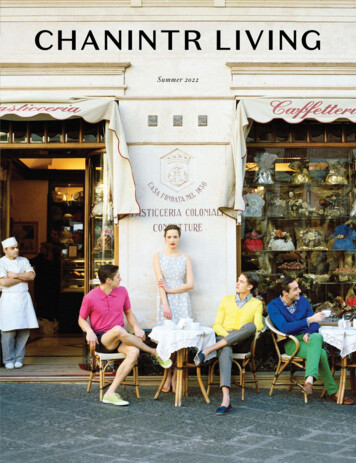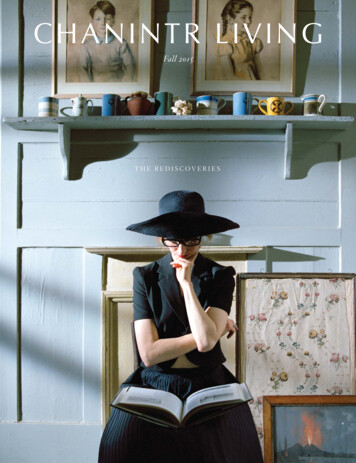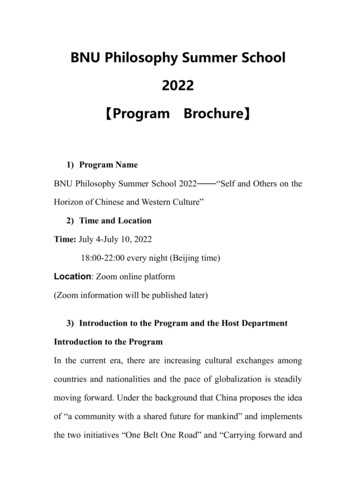
Transcription
Summer 2022
Summer 2022Summer has arrived in the Northern Hemisphere and with many countries aroundthe world just having “opened up,” it is as if the floodgates have been released and atsunami of people are filling up planes, airports, hotel rooms and restaurants with avengeance. Add to that an unusually hot, early summer in Europe and tempers couldeasily rise with the temperature.Here are a few road tested tips we followed on our recent trip to Europe that will keepyou and the planet a little cooler:1. Pick a quality airline that flies nonstop — more connections equals more risks andharm to the environment.2. Choose your equipment — not only are Dreamliners and A350s 20-30% more fuelefficient but they have better air quality, reduce jetlag and lower turbulence.3. Airports make a huge difference to your experience so be strategic — one of ourfavorites is Zurich, small, efficient as a Swiss watch and for design sensitiveeyes, very pleasant. A close second is Munich.4. Drive or take the train as much as possible between places in Europe that havegreat roads and rail networks. And when renting cars, make sure to rent smart.We have been renting Teslas from Driverso but make sure your destinationshave plenty of supercharging stations around. If not, go for a hybrid or fuelefficient option like a Mini Countryman that can handle luggage and thenarrow roads around Como.5. Book hotels and restaurants way in advance when you can but be flexible andwaitlist as many last minute cancellations happen with Covid still lurking.Most of all, relax and go with the flow. After all this time being cooped up, we need to bethankful that one of the joys of living well has come back.Wishing all of you a splendid summer!Chanintr SirisantMEETCHANINTRAND COCHANINTRGPF WITTHAYU, TOWER A, 18TH FLOOR93/1 WIRELESS ROAD, LUMPINI, PATHUMWANBANGKOK 10330 THAILANDCHANINTR.COMTEL: 662 015 8888EDITOR@CHANINTR.COMDESIGN BYCASESTUDYCASESTUDYOFFICE.COMCOVERSAORI WITH MEN, AMALFI, ITALY, 2007BY RODNEY SMITHPHOTOGRAPHYCHANINTR LIVING EXCEPT WHERE NOTED.4 –6 –8 –10 –12 –14 –16 –18 –2122 –24 –2657911131517192325TALE OF THE TWO MASTERSWHAT’S IN HIS KITCHEN?A WEEK AT SALONE DEL MOBILEDISCOVERING OBJECTS OF USEPALAZZO PERFETTOFIT FOR A QUEEN (AND KING)DOLOMITI HAVENPASSIONATE PERSISTENCESUMMER WITH CHOUXPARSONS’ TABLEMATERIAL POSSESSIONSCHANINTR LIVING SUGGESTSA COLLECTION OF WELL-CRAFTEDENVIRONMENTALLY-FRIENDLY FURNITUREDESIGNED BY BARBARA BARRYSIAM PARAGON, 3RD FLOOR 662 129 4577CHANINTRXCO.COMCHANINTRXCO
TALE OF THE TWOMASTERSHOTELCOSTES.COMHOTELCOSTESThe story of the Castiglione wing of the Hotel Costes in Paris isreally a story of two legends and friends. One, Jean Louis Costes,a legend in the world of French food and hospitality, and theother, Christian Liaigre, in the world of design and interiors. Bothmen who were close in age and started from the ground upeventually came to realize incredible success on an internationalscale.Jean Louis came to Paris as a teenager with his brother Gilbertfrom Aveyron. He learned the ropes working in restaurants inParis for 10 years before he embarked on buying his first one andrenaming it Café Costes. In what would foretell his ongoingformula for success, he hired Philippe Starck to design it for him.Fast forward 40 years and he and his brother directly own or arepartners in over 40 restaurants in Paris, not including his,greatest and most renowned accomplishment, the Hotel Costes,which was designed by Jacques Garcia.PHOTOS COURTESY OF HOTEL COSTESChristian, also a country boy from La Rochelle, studied fine artsin Paris and initially practiced art. After toying with the idea ofbeing a professional jockey racing horses, he eventually settledon working for Nobilis, a design studio and fabric house in Paris.After finally casting off on his own in a small shop windowdrawing furniture and doing interiors for friends, he was finallyrecognized by the likes of Karl Lagerfeld and Valentino, designing–04–
homes and offices for them. He went on to create a design studiothat has continued to be one of the most coveted in the worldand an international home interiors brand, Liaigre, withshowrooms around the world.In all the years that I visited Christian in Paris, there was rarely atime that we would not have at least one meal at the Costes. JeanLouis was often there behind the scenes conducting his magic. Ifthere were an award for the one location in Paris (or the world forthat matter) with a combination of extraordinary ambience,consistently excellent food, great music and the most beautifulpeople, it would easily be the reigning king since it opened itsdoors. Although it can be a bit intimidating, dark and provocativeat first, once you embrace it, it is an experience that you willalways go back to.The first collaboration between Jean Louis and Christian was atLa Societe, a stunning, vibrant and sophisticated restaurantacross from the Church of St. Germain des Pres, next door to LouisVuitton and Les Deux Margots. It immediately became theCostes of the Left Bank with the same quintessential vibe andcocktail of beautiful people, high fashion, design, great food andmusic. La Societe was an amuse bouche to what was in theworks. In 2011, Jean Louis purchased the Loti from NH Hotelswhich sat right next door to the Hotel Costes.I still remember the excitement in Christian’s voice when he said thathe would be designing the new hotel. After having gained renownand success in his design for the Mercer Hotel in Soho, HotelMontalembert and Hôtel Lancaster in Paris, and Le Serono inSt. Barts, he set out to design what would be his best and finalhotel project.The concept by Jean Louis was brilliant, to connect two hotelsthrough the heart — the restaurant, each with their own entrancesand style under one brand, Hotel Costes. Every time we would go toParis, Christian would sneak us up to see how things were progressing.His dedication to finish this one took all of his strength, particularlyin his last days, visiting the site with barely enough energy to walk.After seeing the hotel first hand, I have no doubt that Christianwould be very happy, not only because it has realized immediatesuccess but that it would continue to be in the hands of someonehe greatly respected and trusted. It is truly a new landmark ofParis and one in which you can enjoy incredible views of theother landmarks, the Eiffel Tower as well as the Place Vendômewhile being footsteps from the shopping of Rue St. Honore.If you have never stayed at or eaten at the Hotel Costes, you mayhave heard of the Hotel Costes house music by Stephan Pompougnacwhich in itself was an international success.– Chanintr Sirisant–05–
WHAT’S INHIS KITCHEN?DAVIDMELLORDESIGN.COMDAVIDMELLORUKNamed after its founder and one of the greatest designers inBritain, David Mellor Designs specializes in metalwork and isparticularly famous for its timeless cutlery and kitchenware.Established in the 1960s, the company was set up by DavidMellor, a Royal Designer for Industry (RDI), who was a key figurein British design. The brand operates on the principle thatwell-designed equipment can improve your life, and is oftenreferred to as the “cutlery king.”David Mellor’s approach to design has always been that of acraftsman. His insistence on the highest standards and incorporationof his personal technique in each and every one of his designsmakes each Mellor piece is a perfectionist’s dream. David Mellor’scutlery is produced in a purpose-built factory in Derbyshire,England, and with an extensively monitored hand-made productionprocess along with a small team of highly skilled craftsmen, hiscutlery sits both beautifully in the hand and on the dining table,adding effortless elegance and sophistication to anything thatcomes in contact with it.PHOTOS COURTESY OF DAVID MELLORDesigned in 1953, Mellor’s classic collection, “Pride,” has nowbecome one of the most renowned cutlery collection sets of alltime. Also being his earliest piece, the simple elegance of “Pride”encapsulates the ethos of modern design. To this day, its–06–
practicality, simplicity and craftsmanship is unrivaled and haswon numerous design awards for its innovative qualities. It wasin 1963 when Mellor was commissioned by the British governmentto design a cutlery set for use in British embassies, this would bethe first of many prestigious commissions the brand would beasked to produce. Fittingly for such an honorable commission,the “Embassy” collection is one of the grandest sets of cutleryever made by the brand, debuting the never-before-seen conceptof the three-pronged fork. Both sets are available for purchase onthe brand’s website, enabling everyday cutlery enthusiasts toelevate their dining experiences with the spectacular DavidMellor flair in the comfort of their own home.Mellor would go on to design cutlery sets for British hospitalsand prisons, even traffic lights and red post-office boxes for thestreets of London. Today, the David Mellor Design Museum andCafé in Derbyshire honors the legacy of the designer andshowcases all his greatest works. Guests are invited to dine at thecafé where small bites and classic British tea are served on anarray of specialty David Mellor cutlery and kitchenware. It iswithout a doubt that the legacy of David Mellor will forever beattributed to his groundbreaking and pioneering work, withmany innovative forks, spoons, knives and glassware attesting tohis artistic genius.– Shada Vijitkasemkij–07–
A WEEK ATSALONE DEL MOBILESALONEMILANO.ITISALONIOFFICIALThis year’s Salone marked its 60th anniversary. After a two-yearhiatus and postponement due to the pandemic, everyone waseager for the event’s return. In our photo diary, we highlight someof the most memorable moments we saw at Salone. From Minottiand Saint-Louis to Hermès and Kohler, catch a glimpse of thelatest in the design world.PHOTO COURTESY OF MINOTTIEvery April — or in 2022’s case, June — design lovers from all overthe globe gather in Milan for Salone del Mobile, otherwiseknown as Milan Fair. For one week, more than 2,000 furnitureand home brands take to Rho Fiera Milano Exhibition Centre todisplay their newest, brightest and most innovative. Meanwhilein town, palazzos, courtyards, galleries, industrial spaces,apartments and showrooms all get creatively transformed tohouse product launches and installations.Minotti’s booth at Salone del Mobile saw the launch of many new piecesfrom Rodolfo Dordoni, Marcio Kogan and newcomer Inoda Sveje. Thepandemic and our shift in lifestyle inspired a number of products, includingthe new lounge table that’s meant to be placed in the living area for gamenights, work time, as well as casual meals.PHOTO COURTESY OF TIME & STYLE– Uracha ChaiyapinuntPHOTO COURTESY OF DANIEL ARSHAMPHOTO COURTESY OF ELISABETH HEIERTime & Style, a Japanese furniture brand, had the grand opening of theirMilan showroom during Design Week. Established in 1990, the brand offers awide range of products — furniture, lighting equipment, tableware andsmall accessories — and has collaborated with some of the greats, includingPeter Zumthor and Kengo Kuma.Louis Poulsen took over Taveggia, an old pastry shop in Milan, to introducethe exclusive PH Pale Rose that’s only available for a limited time on thebrand’s website. Other iconic pieces that were spotted in the space include thePH Artichoke and PH Septima.–08–Kohler teamed up with American contemporary artist Daniel Arsham tocreate “Divided Layers,” the Instagram-famous installation at the PalazzoDel Senato. “Divided Layers” won the Fuori Salone prize that's awarded to themost distinctive project presented during the festival.
PHOTO COURTESY OF KETTALPHOTO COURTESY OF SAINT-LOUISFrench crystal manufacturer Saint-Louis displayed their new Cadencecollection by Pierre Charpin in a historic piazza in the heart of Milan’s Breradistrict. The 29-piece collection spans everything from vases and tumblers tofruit bowls and lamps.PHOTO COURTESY OF MARUNIPHOTO COURTESY OF CASA MUTINAKnown for their contemporary outdoor furniture and workplace solutions,Spanish brand Kettal went all out to showcase their newest products at thefairgrounds. It was the first time that the public got to see the Arc collectionand new works from Patricia Urquiola and Miguel Milá in person.Italian tile company Casa Mutina Milano exhibited “Elementi per paesaggi”by French artist Nathalie Du Pasquier that featured colorful glazedcompositions that the brand is known for.PHOTO COURTESY OF TONPHOTO COURTESY OF URACHA CHAIYAPINUNTHiroshima-based Maruni debuted its series with Danish designer CecilieManz. Named En, which means “one” in Danish and “circle” in Japanese, thecollection consists of skillfully crafted wooden tables and chairs.No one does it like Hermès. For the first time, textiles are the central theme ofthe brand’s home collection. All of the six creations on display are made fromcashmere, one of Hermès’ favorite materials.Ton continually evolves with the times to produce quality products. The 822collection and P.O.V. series answer to modern day consumer needs andchanging lifestyle.–09–
DISCOVERINGOBJECTS OF USEOBJECTSOFUSE.COMOBJECTSOFUSEHand-dipped beeswax candles made in Cumbria. Japanese Akebivine baskets that keep fruit wonderfully fresh. Pine-tar soapmade on the west coast of Finland that smells subtly ofwoodsmoke when lathered. These are just a few of the itemsyou might stumble across on a visit to Objects of Use.Born out of a deep reverence for time-honored traditions and theitems that make up our everyday rituals, Objects of Use is a shopthat sells enduring household tools and functional objects inOxford. Its cheerful storefront is located just a few minutes awayfrom the Radcliffe Camera and the historic Covered Market —two of the area’s most famous landmarks — but its thoughtfullysourced goods are also available online, for those who are unableto make the trip to Market Street.PHOTOS COURTESY OF OBJECTS OF USEThough Objects of Use has been described as a modern-dayhardware store, it is a far cry from the cavernous warehousesthat stock aisles of plywood and power drills. Instead, its ownersHazel Rattigan and Alexis Dexter curate practical items that helppeople to slow down and enjoy their daily rituals. “We believethat having the right tool for the job vastly improves the experienceof completing our daily tasks,” explains the duo. At Objects ofUse, these tools are lovingly referred to as everyday archetypes —“items that have been made in the same way, by the samepeople, for a long time.”–10–
The pair opened their shop over twelve years ago, approachingthe project with combined expertise honed through careers ingraphic design and fine art. Dexter studied fine art at Goldsmithsand Oxford and created sculptures and furniture, working withacclaimed figures like architect Zaha Hadid and artist RachelWhiteread. Rattigan, on the other hand, pursued design atCentral Saint Martins and the Royal College of Art and went onto establish her own design studio.Their creative backgrounds greatly informed the direction ofObjects of Use, and this influence can still be seen in the storetoday. There is an artfulness to the selection of items on offer —they are highly functional, yet still retain an irresistible sense ofwonder and play. From German goat hair brushes designed tomake quick work of dusting, to Swedish bootjacks shaped like stagbeetles, these objects are sourced from all across the world as wellas closer to home, with many British items also lining the shelves.The owners have traveled to meet the makers of their wares inperson, hopping on flights that took them to workshops in Hokkaido,Tokyo and Kyushu. But they also travel virtually, using GoogleTranslate to communicate with makers across language barriers.locale-specific cultures that led to their invention. “We’re reallyinto the idea of evolved and vernacular products — things thatdon’t have one single designer but have developed throughgenerations to become the best version of themselves,” saysRattigan. “These are proven designs that are completely rootedin the place they’re from.”The store champions sustainability and considered consumption,a philosophy that is the very antithesis of our prevailingthrowaway culture. The items they sell are made with low-impactmethods and materials, and built to last or even improve withage. There is a preciousness to this approach — these are tools tobe bought once and then treasured for a long time. True to theirname, Objects of Use is in the business of selling things that helpto make life more beautiful.– Petch KingchatchavalBeyond the usefulness of their products, Dexter and Rattiganaim to impart knowledge through Objects of Use — to foster anappreciation for handmade processes, natural materials, and the–11–
PHOTOS COURTESY OF URACHA ZO.DANIELE–12–Italy is always a good idea. There’s a city or a region for everyoccasion: first-time visitors can take in the historical landmarksand incredible local eateries of Rome; creatives will fall in lovewith the hustle and bustle of Milan; and honeymooners can pickfrom a variety of scenic landscapes from the Amalfi Coast up tothe Dolomites. But for those looking to escape and slow down, I’dargue there’s no better place to do that than Puglia.Though already popular among locals and tourists, this Southernregion of Italy — situated at the heel of the boot — often getsovershadowed by the more developed, and thus rowdier, towns.That’s the magic of Puglia though. Quieter, easier going and morerelaxed, Puglia possesses rural beach town charm that’s rare tofind anywhere else. A hotel that manages to capture this essenceis Palazzo Daniele.
Palazzo Daniele dates back over 150 years ago when it was firstconstructed as a family palazzo in the sleepy town of Gaglio del Capo.Designed by renowned architect Domenico Malinconico, the spacefeatured numerous courtyards and Mediterranean landscaping thatare still preserved today. In 2019, the palazzo was reimagined as aluxury nine-suite boutique hotel that melds the old 19th-centurysplendor with the new: contemporary furnishings sit under highvaulted ceilings and restored frescoes; a swimming pool andoutdoor lounge area have been added; and a modern minimalistapproach has been taken in the crafting of the project.The main difference you’ll experience at Palazzo Danielecompared to the typical five-star accommodation lies within theservice. Upon entering the property, guests will spot the quotequesta casa non è un albergo (“this house is not a hotel”) hung upon the foyer’s wall in neon yellow sign. This credo is at the centerof staff-guest interactions. You won’t find extravagance atPalazzo Daniele — no fine dining menu, designated butler, valetparking or anything of the kind. What you’ll find is a family. Inthe afternoon, chefs invite you to the kitchen to taste whatthey’ve been prepping for dinner. Denis, the mixologist, surprisesyou with an off-the-menu, personalized cocktail at the pool. AndEmanuele, who takes care of the place, hands you a plate offreshly baked cookies as you make your way back to your roomfor bed.During the day, the hotel’s location makes exploring the Adriaticcoastline and the Ionian Sea a breeze as well. Drive along thehighway where plenty of beaches, swimming holes and grottoesawait. If you’re spending a few days in the area, take longer tripsto bigger towns like Lecce, Castro and Ostuni for meals. Just besure to pack a bathing suit and some SPF as you’ll want to jumpinto the clear waters any chance you get. This is dolce far niente inits truest form.– Uracha Chaiyapinunt–13–
PHOTO COURTESY OF SAINT-LOUISTHIS COLLECTIONPAYS HOMAGE TOTHE BRAND’SSTRONG TIES TOTHE FRENCH ROYALS.
FIT FOR A QUEEN(AND KING)SAINT-LOUIS.COMSAINTLOUISCRYSTALEstablished in 1586 in the French forest of Moselle, the MüntzalGlassworks — or better known today as Cristallerie Royale deSaint-Louis (Saint-Louis Crystal) — has been perfecting the art ofhand-made, mouth-blown glass creations for more than 436years. The signature clarity, density and sonorous luminosity ineach Saint-Louis piece are unrivaled, as they illustrate andencompass the rich history and craftsmanship of the brand. Fourcenturies later, Saint-Louis continues to feature the skills andvision of modern influential designers to open the way to newuses for crystal and glassware, incorporating notable stylisticconcepts from the 20th century such as Art Deco and Art Noveau.Designers such as Paul Nicolas, Jean Luce and Hervé van derStraeten have all had their hand in working with the brand tocreate contemporary and inspiring pieces that helped enrich theextensive history of the brand. With such a prestigious name andlegacy, the brand may have changed hands throughout itslifetime, but its values and quality remain untouched andunchanged.The brand’s newest collection, Kings’ and Queens’ Hall, payshomage to the brand's strong ties to the French royals during the18th century. In 1767 Versailles, King Louis XV signed the patentletter that appointed Saint-Louis Crystal as the royal manufacturerof glassware. The collection serves as a testament to the strongbond between the two houses, as it offers a tribute to the fourkings and queens of France who have made a mark on Versailles:Maria Theresa of Austria, Marie Leszczynska, Marie-Antoinette ofAustria, Maria Amalia of Naples and Sicily, Louis XIV, Louis XV,Louis XVI and Louis-Philippe.The four Queens, represented by four different crystal stemwareglasses, are honored through intricate beveled cut designscarefully engraved into the crystal-clear glass, with the additionof the royal monogram of each queen and the Palace of Versaillesx Saint-Louis seal symbolizing the renewed bond. The kings arerepresented by four crystal tumbler glasses featuring differentbeveled cut designs, with inspiration drawing directly fromdistinct characteristics and the decorative styles in fashion undertheir reigns. The glasses are short and sturdy, allowing foroptimal ergonomics for use with water or wine. In a range ofsizes, the pieces form a crown when viewed from above for aroyal pas de deaux. With the aim to reinvent a royal table whenused in unison, this collection marvelously outlines the full arrayof Saint-Louis' expertise.– Shada Vijitkasemkij
PHOTOS COURTESY OF VILLA ARNICADOLOMITI HAVENVILLAARNICA.COMVILLAARNICASurrounded by nature and entangled in vineyards, Villa Arnicacaptures the serene and private village lifestyle of South Tyrol.Situated in the quaint town of Lana, South of Italy, theaward-winning luxury villa was first built in 1925 as a mansionfor Italian engineer Luis Zuegg. It features 10 guest rooms, tworestaurants and a much appreciated adults-only policy. Theunder-the-radar town of Lana means the property is bedeckedwith palm trees and fruit orchards, with the villa itself growingfresh produce on the luscious farmland for its restaurants, all ofwhich are encircled by the jagged outlines of the Dolomites. Theonly expected sounds here are birdsongs from the garden and thesubtle tolling of bells from a nearby church. It’s a two-hour driveto Valerio Catullo, the closest international airport.Owner Klaus Dissertori along with architect Franz Petek andinterior designer Christina Biasi-von Berg has recently refashionedthe villa to honor the history of the structure’s heritage. Thehotel’s mid-century exterior pays homage to stylistic architecturaltrends of the old world, while the modern-contemporary furnishingsserve as a testament to the historical grandeur of the place and itsexcellent craftsmanship. Though the structure of the villa itself is–16–
almost 100 years old, the property still boasts contemporaryopulence; Zucchetti bathroom fittings, terrazzo tiles and raw oakfloors reflect the villa’s rich history and original color schemedating back to 1925. Pieces from local craftsmen are also featuredin the hotel’s interior, a nod to the artistry of southern Italy.Decadent nibbles and gastronomic meals are offered at theSalotto in the villa or the pool house nestled in the garden.Breakfast, lunch, tea and dinner are served farm-to-table, freshlyprepared by skilled local chefs with greens and grains directlyplucked from the villa’s communal garden. Quintessence fresh.Guests are kept entertained by holistic activities offered at the villaand surrounding areas: bicycles are available for rent to freewheelaround the cobblestone streets of Lana, the outdoor pool with adreamy retro pool house is available for a quick cool-down, whilethe meditation house is open for guest use with yoga sessions uponrequest. Once that’s done, guests can retreat to a state-of-the-artbedroom that is sure to guarantee a restful evening.It is clear why Villa Arnica has been highly praised by renownedtravel magazines and guests alike, as the classically charming andtimeless grandeur of the place guarantees a low-key but fulfillinggetaway. The small presence of staff around the villa makes stayingat Villa Arnica akin to staying at your personal holiday home in thecountryside, a great reset for those who need a break. “The guestshould [leave Villa Arnica] with familiar feelings, as if they havespent time at a friend's villa,” says owner Klaus Dissertori. “It’s anauthentic experience that we are trying to offer people.”From standard double rooms elegantly furnished with a cozysitting area to the generously sized suite, the hotel offers absoluteprivacy with an incomparable view. Bathrooms are outfitted inLasa marble and feature organic amenities from SusanneKaufmann. Frequent guests are often a mix of affluent couplesfrom Italy and neighboring countries like Austria, Switzerlandand Germany, who have long been vacationing in the region.– Shada Vijitkasemkij–17–
GESA mild ocean breeze, warm rays of sunlight and dazzling greenfields of ripening grapes: the charming landscape of the Médocregion is home to none other than Château Lynch-Bages. Nestledalong the Bordeaux wine route, Château Lynch-Bages has beenproducing elegant, sophisticated wine for centuries. Each bottleoffers a distinct flavor profile, from textbook Pauillac-style redsto flavourful and floral whites.Over the years, each owner has pushed the estate to newfrontiers, innovating and implementing new oenologicalmethods in order to expand the future of winemaking as well asenrich the legacy of the estate. With the inauguration of its newvat room in 2020, a look back at the history of the estate bringsclarity to its vision moving forward.PHOTOS COURTESY OF CHATEAU LYNCH-BAGESThe story of the Château starts in the 17th century, with thegrouping of plots around the village of Bages by Jean Déjean andhis brother Pey. Later, in the 18th century, the descendants ofIrishman John Lynch brought new life to the vineyards bysystematically draining soils and selecting the best grapevarieties to cultivate on the fertile land. Most significant, though,–18–
was the building of a “new system” vat house in the 19thcentury. Inspired by Pierre Skawinski’s two-story vat room,which allowed wine producers to take advantage of gravity tomanage grapes, Jérôme Cayrou’s installation of the new facilityin 1866 ensured that Château Lynch-Bages employed the bestwine-making techniques of the period.Since then, the development of functional and sophisticatedwine making has been at the fore of the operations at Lynch-Bages.Their wines are characterized by a finesse and regularity thatbrought recognition from all around the world. With the rapidoenological inventions of the 20th century — the incorporationof destemmers, crushers, horizontal presses, stainless steel vatsand other equipment into standard industry practice — it is nosurprise that the wines of Lynch-Bages wines were revolutionized too.Changes were occurring not only in the winery, but also in thevineyard. Under the care of Jean-Charles Cazes, a thoroughexamination of the vineyard was undertaken in 2006 to alignthe estate with cutting-edge viticultural developments. Satellitemapping tools allowed an extensive study of the different grapevarieties, their quality and maturity, vine condition and soil typein order to precisely understand the terroir and unlock the fullpotential of each parcel of land. As a result, the vineyard wasdramatically reorganized and the plans for a new winery weredrawn up.Bold, airy and modern, the new vat room of the ChâteauLynch-Bages embodies the passion and persistence of itspredecessors. Designed by Louvre Pyramid architect ChienChung (Didi) Pei, the building is defined by the clean lines ofstainless steel, eye-catching glass panels and grounding earthtones of industrial concrete. By emphasizing functionality andinnovation without losing out on sophistication and style, theserenovations represent the excitement of the future as well as theimportance of the past. The 2020 vintage is the culmination offour centuries of progress and four years of diligent work,marking the beginning of a new chapter for the estate.– Chanikarn Kovavisarach–19–
MIRA FROM BEHIND IN THE TROCADÉRO, PARIS, FRANCE, 2007AT TENTION: ART COLLECTORS, STOCK BROKERS,DAYDREAMERS AND THOSE WHO ALREADY HAVE IT ALL.The limited-edition archival pigment prints by world-renowned photographer Rodney Smith are available exclusively through CHANINTR .Each image is masterfully hand printed in a limited edition of Twenty-Five. Pricing starts at 10,000. Prices are based on the edition number available and print size requested.F O R M O R E I N F O R M AT I O N, P L E A S E C O N TA C T A C Q U I S I T I O N @ C H A N I N T R . C O M O R BY C A L L I N G 6 6 8 4 76 0 8 2 8 2RODNEY SMITHR O D N E YS M I T H .CO M
PHOTOS COURTESY OF DANIELLE TSISUMMER WITH CHOUXThey’re warm. They’re delicate. They’re drenched with chocolatesauce and melt in your mouth. What’s not to love?A profiter
2. Choose your equipment — not only are Dreamliners and A350s 20-30% more fuel efficient but they have better air quality, reduce jetlag and lower turbulence. 3. Airports make a huge difference to your experience so be strategic — one of our favorites is Zurich, small, efficient as a Swiss watch and for design sensitive eyes, very pleasant.










